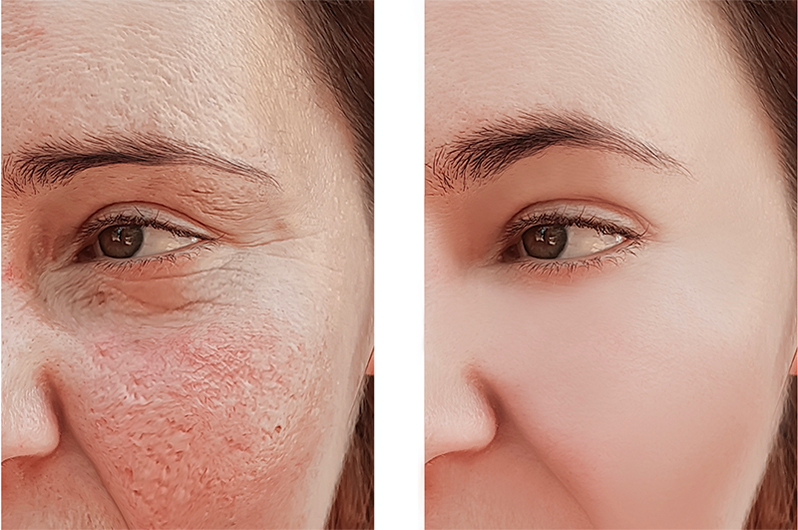Introduction
Laser resurfacing has gained immense popularity in recent years as a highly effective cosmetic procedure to rejuvenate and enhance the skin. It is a minimally invasive treatment that can address a wide range of skin concerns, making it a versatile option for individuals seeking to improve their skin’s texture, tone, and overall appearance.
This comprehensive article delves into the world of laser resurfacing, exploring its benefits, applications, and what sets it apart from other skincare treatments. Whether you’re looking to reduce wrinkles, erase acne scars, or improve sun-damaged skin, laser resurfacing offers a solution worth considering.
Why Should You Use Laser Resurfacing?
Laser resurfacing is an innovative and powerful skincare technique that employs concentrated light beams to target specific problem areas on the skin’s surface. It is an excellent option for anyone seeking to revitalize their skin and address various imperfections. Here are some compelling reasons why you should consider laser resurfacing:
- Effective Wrinkle Reduction: Laser resurfacing can significantly reduce the appearance of wrinkles and fine lines, helping you achieve smoother, more youthful-looking skin. The treatment stimulates collagen production, which is crucial for maintaining skin elasticity and reducing wrinkles.
- Scar Removal: Whether caused by acne, injury, or surgery, scars can be bothersome and impact self-confidence. Laser resurfacing can minimize the appearance of scars, promoting a more even skin texture.
- Even Skin Tone: If you struggle with uneven skin tone or hyperpigmentation, laser resurfacing can help. It targets areas of excess pigmentation, effectively evening out your skin tone.
- Sun Damage Repair: Overexposure to the sun’s harmful UV rays can lead to premature aging and skin damage. Laser resurfacing can reverse some of this damage and restore your skin’s natural radiance.
- Boost in Confidence: Achieving smoother, more youthful skin can lead to increased self-esteem and confidence in your appearance.
The Laser Resurfacing Procedure: A Closer Look
Before opting for laser resurfacing, it’s essential to understand the procedure and what it entails. Laser resurfacing is typically performed by a trained dermatologist or a licensed skincare professional. The process involves the following steps:
Consultation and Evaluation: The first step is to consult with a qualified professional who will assess your skin condition and discuss your desired outcomes. They will determine if you are a suitable candidate for laser resurfacing.
Preparation: Before the procedure, you may need to avoid certain skincare products and medications to ensure the best results and reduce the risk of complications.
Anesthesia: Depending on the depth of the treatment, the procedure may require local anesthesia or sedation to manage discomfort.
Laser Treatment: The dermatologist will use a specialized laser device to target the specific areas of concern on your skin. The laser energy will remove damaged skin layers and stimulate collagen production.
Types of Laser Resurfacing Treatments
There are different types of laser resurfacing treatments available, each catering to specific skin concerns and conditions. Understanding the various options will help you and your skincare professional decide which treatment is best suited to your needs. The following are the most common types of laser resurfacing:
CO2 Laser Resurfacing: This type of laser resurfacing uses carbon dioxide lasers to remove layers of damaged skin. It is highly effective for treating deep wrinkles, scars, and warts.
Erbium Laser Resurfacing: Erbium lasers are milder than CO2 lasers and are ideal for treating superficial skin concerns. This treatment is often recommended for individuals with darker skin tones.
Fractional Laser Resurfacing: Fractional laser resurfacing treats only a fraction of the skin’s surface, leaving surrounding tissues intact. It promotes faster healing and is suitable for a wider range of skin types.
Non-ablative Laser Resurfacing: This type of laser resurfacing targets the underlying layers of the skin without damaging the surface. It is a gentler option with minimal downtime.
Preparing for Laser Resurfacing: What to Expect
Before undergoing laser resurfacing, it’s essential to prepare yourself both mentally and physically for the procedure. Here are a few critical elements to consider:
- Consultation and Skin Evaluation: Schedule a consultation with a qualified dermatologist or skincare professional. They will assess your skin condition, discuss your medical history, and determine if laser resurfacing is the right option for you.
- Understanding the Risks and Benefits: While laser resurfacing is generally safe, it’s essential to be aware of potential risks, such as temporary discomfort, redness, swelling, and rare complications like scarring or infection. Weigh these risks against the numerous benefits before making your decision.
- Discontinuing Certain Medications and Skincare Products: Your dermatologist may advise you to stop using certain medications or skincare products that could interfere with the procedure or affect your skin’s healing process.
Aftercare Tips for Optimal Results
After undergoing laser resurfacing, taking proper care of your skin is crucial for achieving the best possible results. Here are some essential aftercare tips to follow:
- Keep the Treated Area Clean: Gently cleanse the treated area with a mild, non-abrasive cleanser as advised by your dermatologist. Avoid using harsh products that could irritate your healing skin.
- Moisturize Regularly: Hydrate your skin with a gentle, non-comedogenic moisturizer to promote healing and soothe any dryness or flakiness.
- Avoid Direct Sun Exposure: Protect your skin from the sun’s harmful rays by staying indoors or wearing a wide-brimmed hat and using a broad-spectrum sunscreen with at least SPF 30.
- Refrain from Picking or Peeling: Allow your skin to heal naturally without picking at scabs or peeling skin, as this could lead to scarring and interfere with the healing process.
- Avoid Strenuous Activities: Refrain from engaging in strenuous physical activities or exercises that could cause sweating and potentially irritate the treated skin.
- Follow-Up with Your Dermatologist: Attend follow-up appointments with your dermatologist to monitor your skin’s progress and ensure proper healing.
Frequently Asked Questions (FAQs)
Can laser resurfacing treat all skin types?
While laser resurfacing is generally safe for various skin types, certain lasers may be better suited for specific skin concerns and tones. Consult with your dermatologist to determine the most suitable treatment for your skin type.
Is laser resurfacing painful?
The level of discomfort experienced during laser resurfacing can vary from person to person. Some individuals may feel minimal discomfort, while others may opt for local anesthesia or sedation for a more comfortable experience.
How long does it take to get over laser resurfacing?
The restoration duration for laser resurfacing relies upon the depth of the remedy and man or woman recovery factors. In most cases, the skin will heal within 1 to 2 weeks, during which you may experience redness and mild swelling.
Are there any side effects of laser resurfacing?
While laser resurfacing is considered safe, there may be some temporary side effects, including redness, swelling, and minor irritation. These results generally subside within some days to a week.
Can laser resurfacing remove all types of scars?
Laser resurfacing is effective for reducing the appearance of many types of scars, including acne scars, surgical scars, and scars from injuries. However, the extent of development may also range relying on the scar’s intensity and severity.
Is laser resurfacing suitable for dark skin tones?
Yes, certain types of laser resurfacing, such as erbium lasers and fractional lasers, are safer for individuals with darker skin tones. However, it’s essential to consult with a skilled dermatologist to avoid potential complications.
Conclusion
Embrace Radiant Skin with Laser Resurfacing
Laser resurfacing offers a revolutionary solution for achieving smoother, younger-looking skin and addressing various skin concerns. With its ability to reduce wrinkles, erase scars, and improve skin texture, it has become a popular choice for individuals seeking effective and long-lasting skincare treatments.
If you’re looking to boost your confidence and achieve radiant skin, consider the benefits of laser resurfacing. However, it’s crucial to consult with a qualified dermatologist or skincare professional to determine the best treatment plan for your unique skin type and concerns.
Unlock the potential of laser resurfacing and experience the transformational power it holds for your skin’s health and appearance.



